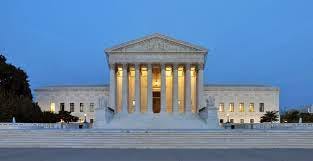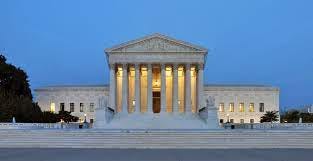Why We Need to Expand The Supreme Court
We didn't listen to the warnings in 2016 and now look at what SCOTUS is doing.
Issue #585 The Choice, Monday, April 29, 2024
A full podcast of the audio for the eight weekly W.A.S. posts from the previous week will be published every Tuesday on Apple Podcasts and Spotify Podcasts.
Please also scroll to the end of this post for other ways to financially support We Are Speaking.
We appreciate your support!
The Supreme Court of the United States (“SCOTUS”) was established by Article III of the Constitution, ratified in 1789. The Court was created as the highest court in the federal judiciary system, with the power to interpret the Constitution and federal laws, and to resolve disputes between states. The Court originally consisted of six justices, including a Chief Justice. Over the years, the size of the Court has varied, with Congress changing the number of justices several times. The current size of the Court is nine justices.
The current president of the United States recommends a person for the Supreme Court, and the Senate confirms or denies the person for appointment by a simple majority vote after a hearing. Associate Justice Ketanji Brown Jackson was recommended in February 2022, by President Joe Biden, and her appointment to the Supreme Court was confirmed on April 8, 2022. At the time, Judge Brown Jackson was a United States Circuit judge in the United States Court of Appeals for the District of Columbia Circuit, which is considered the 2nd most important court in the United States. Immediately after the Senate vote, all Senate Republicans except Mitt Romney rudely turned their backs on Judge Brown Jackson and walked out of the Senate Chamber because they lost.
In 2016, then-Senate Majority Leader Mitch McConnell refused to give Merrick Garland, who had been nominated by then-President Barack Obama, a hearing in the spring, claiming that it was an election year, and justices shouldn’t be confirmed “so close” to a presidential election.
However, after the death of Associate Justice Ruth Bader Ginsberg in September 2020, then-President Donald Trump immediately nominated his 3rd SCOTUS pick, Amy Coney Barrett, who was quickly confirmed by the Republican-controlled Senate in October, less than a month before that 2020 presidential election, and while early voting had already started. This gave the Court a 6-3 conservative majority.
All of Trump’s appointees swore under oath during their Senate hearings that Roe v Wade was stare decisis, meaning in Latin “to stand by things decided”, that they would not change, but then as soon as possible, reversed the constitutional right to abortion anyway in June 2022.
During the 2016 presidential election campaign, President Barack Obama and Secretary Hillary Clinton both warned that the election was “about the Supreme Court.” People didn’t listen and gave Trump an Electoral College win even though he lost the popular vote to Hillary by more than 3 million votes.
In 2013, with a 5-4 conservative majority, the SCOTUS decimated key areas of the Voting Rights Act in Shelby County v Holder, and in 2022, with a 6-3 conservative majority, the SCOTUS reversed Roe v Wade taking away the constitutional right to obtain an abortion. For both of these cases, the SCOTUS said it was leaving decisions on these issues “up to the States,” but since Republicans are in charge of the majority of state legislatures, extreme measures are being enacted in those states.
Now Donald Trump, Republicans, and the conservative members of the Court are promising to enact a nationwide abortion ban as well as eliminate IVF services and access to all forms of birth control, completely taking away women’s rights to their own reproductive health.
Federal courts hear cases involving the constitutionality of a law, cases involving the laws and treaties of the U.S. ambassadors and public ministers, disputes between two or more states, admiralty law, also known as maritime law, and bankruptcy cases.
When exercising its appellate jurisdiction, the Supreme Court, with a few exceptions, does not have to hear a case. The Certiorari Act of 1925 gives the Court the discretion to decide whether or not to do so. In a petition for a writ of certiorari, a party asks the Court to review its case. The Supreme Court agrees to hear about only 100-150 of the more than 7,000 cases that it is asked to review each year.
Originally, Supreme Court justices also served as circuit court judges. Circuit courts were lower federal courts that were responsible for hearing cases in specific geographic regions, or circuits, across the country. Justices would travel to different circuits to hear cases and also serve as trial judges in those circuits.
Congressional legislation set the number of Justices at 9 in 1869. The change before that was to reduce the number to 7, in 1866 to prevent then-President Andrew Johnson from appointing any. It was returned to 9 justices when President Ulysses Grant took office.
In 1891, Congress passed the Judiciary Act of 1891, which created the circuit courts of appeals. There are presently 13 circuit courts of appeals, and the SCOTUS justices no longer have to also act as circuit court judges.
During every presidential election season, the Republicans demand that the Democratic candidate declare that they will not “stack the Court” if they are elected, even though that is exactly what the Republicans have done.
This election year, the Democrats have the chance the expand the number of Supreme Court Justices in 2025 if/when they re-elect Biden-Harris, take back control of the House, and keep and expand their majority in the Senate.
Since the number of SCOTUS Justices has almost always depended on the number of circuit courts, it makes sense to increase the number of justices from nine to thirteen. This would re-balance the Supreme Court to 8 liberal judges and 5 conservative justices, especially since justices like Thomas and Alito have shown they are controlled by far-right organizations and the three Trump-appointed judges went against what they said they would do under oath.
It only takes 51 Senate votes to confirm a SCOTUS appointment. We can easily expand the Court to 13 members.
This is why your vote all up and down the ballot in November is so very important.
The “Comments” feature is available for paid subscribers. You can also discuss these facts in our community on Substack Notes. You can also read other Substack publications without subscribing to them when you join Notes.
This post is free to read/listen to. To financially support “We Are Speaking” for no more than $5 per month, please subscribe at the paid level. You will receive a 7-day FREE trial!
Independent Authors and Creative Professionals: Branding and Marketing Courses and Networking Groups are available in the GCC Branding and Marketing Academy!
Pam’s Business Books and Keith’s SciFi Books are available for purchase here!






